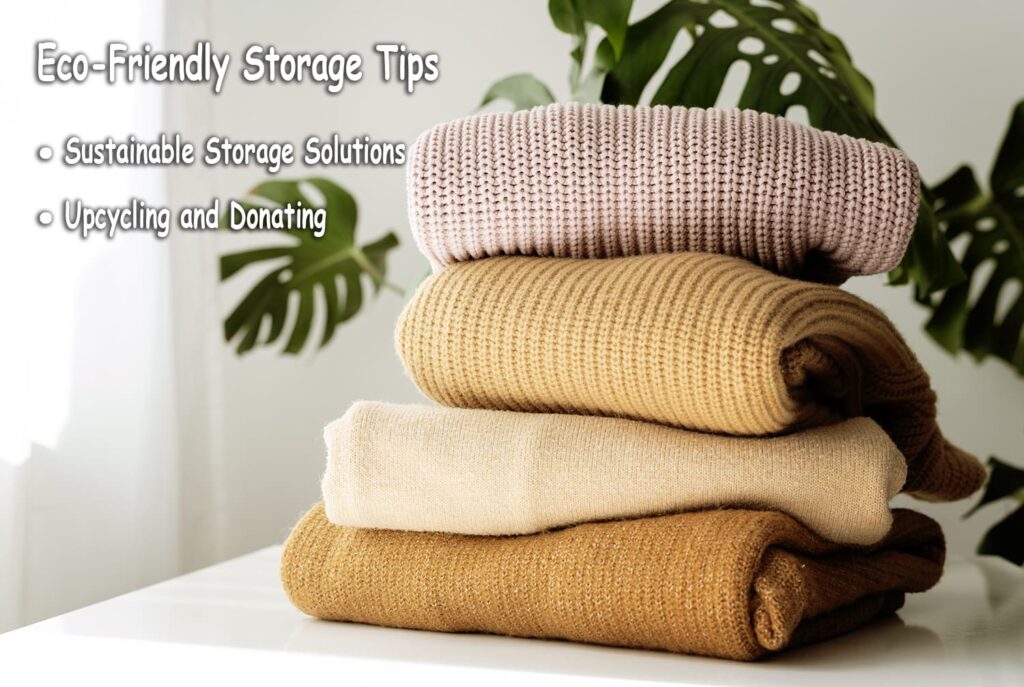Here are six tips on how to store winter clothes for kids:
1. Wash and thoroughly dry all winter clothes before storing them to prevent mold, mildew, and insect infestations.
2. Store clothes in airtight plastic bins or vacuum-sealed bags to keep out moisture, dust, and pests.
3. Clearly label each container with the contents and size, so you can easily find items next season without opening every box.
4. Fold knitted items like sweaters to prevent stretching, and avoid using hangers, which can cause them to lose shape.
5. Place cedar blocks or lavender sachets in the storage bins to keep clothes smelling fresh and to deter moths.
6. Keep the bins in a cool, dry area, like a closet or under the bed, away from direct sunlight or humid areas like basements.
Table of Contents
Winter brings a magical mix of snowflakes and cozy evenings. My kids love winter a lot as they get the chance to play with the snow. However, as the season ends, storing my kids’ bulky winter items becomes quite a task to me. If you’ve ever struggled to find space for all the coats, boots, and knitwear, you’re not alone. I used to face the same challenges until I discovered a few practical solutions that made the process much easier.
In this blog, I’ll share my tips and tricks on how I efficiently store my kids’ winter clothing. From this blog you will learn how to store winter clothes for kids and keep them in good condition for the next season. Proper storage not only extends the life of winter clothes but also saves money by reducing the need for frequent replacements.
How to Store Winter Clothes

1. Preparing Winter Clothes for Storage
Cleaning and Washing
I clean my kids’ winter clothes thoroughly before storing. My kids easily make their clothes dirty while playing in the snow. The dirt’s, sweats, and food stains can easily attract pests and lead to unpleasant odors. For wool garments, I give them a gentle hand wash or a delicate machine cycle with cold water. I use a mild detergent and avoid wringing out the water, as it can stretch the fibers.
Before giving a regular machine wash to synthetic fabrics check the care labels first. You should wash down-filled items, like jackets with a down-specific detergent and dry them with a clean tennis ball to maintain their fluffiness.
Repair and Maintenance
I do some small repairs before storing my kids’ winter clothes. If you want to preserve the longevity of your kids’ winter clothes, small repairs can make a big difference. Before storing, check each item if there are any loose buttons, broken zippers, or tiny tears. I always check and fix these issues to prevent further damage. It saves my time and money for the upcoming winter. Also, tackle any stubborn stains or fabric pilling. You can use a fabric shaver to remove pills from sweaters, making them look fresh and new.
Drying and Freshening
You have to ensure that clothes are completely dry before storing them. It prevents mold and mildew. I prefer air-drying, especially for wool and down items. To freshen up clothes, I use fabric fresheners or natural alternatives like lavender sachets or baking soda. These not only keep the clothes smelling nice but also help to protect from pests.
2. Choosing the Right Storage Solutions
Storage Containers
The right storage containers can make a big difference in preserving your kids’ winter clothes. I use plastic bins because they protect against moisture and pests. However, before using you have to make sure they are made of BPA-free plastic to avoid any chemical leaching. Vacuum-sealed bags are also excellent for saving space, especially for bulky items like coats and jackets. They compress the clothes and make them easier to store. But you have to be cautious with delicate fabrics as the compression can sometimes damage them. For more delicate items I use fabric storage bags as they allow for some air circulation. It reduces the risk of mildew.
Labeling and Organization
It’s very important to label the storage containers. Once you’ve chosen your storage containers, label them clearly. Labels should include the contents and the size or age group of the clothes. I label my storage containers and this saves my time when I’m looking for specific items next season. I organize the clothes by size, type, or even season. For instance, you can group all the sweaters together or separate the winter gear by child. This system helps keep everything organized and easily accessible.
3. Optimal Storage Conditions
Temperature and Humidity Control
To preserve the quality of winter clothes you have to maintain the right storage conditions. Usually, I store the containers in a cool, dry place. Basements and attics can work, but they often experience temperature and humidity fluctuations. If these are your only options, consider using a dehumidifier to keep the moisture levels in check. Avoid storing clothes in areas with high heat or humidity, as these can lead to mold growth and fabric damage.
Avoiding Direct Sunlight and Pests
Always try to keep storage containers out of the sun, as direct sunlight can cause fabrics to fade. To protect against pests, I use natural repellents like cedar blocks or lavender sachets. Mothballs are also effective but can leave a strong odor. So if you use them, place them in a separate, well-sealed container.
Storing Different Types of Winter Clothing

Storing Coats and Jackets
When it comes to coats and jackets, hanging versus folding depends on the material. I fold and store synthetic jackets in vacuum-sealed bags. However, I hang the leather jackets on padded hangers to maintain their shape. For wool coats, I use a breathable garment bag to protect against moths while allowing some air circulation.
Storing Sweaters and Knitwear
I fold sweaters and knitwear rather than hang to prevent stretching. I store them in fabric bags or plastic bins with some room to breathe. You can place a sheet of acid-free tissue paper between layers to prevent creases and keep the sweaters in shape.
Storing Accessories
Winter accessories like hats, gloves, scarves, and boots require special attention. I place small items like hats and gloves in separate, labeled bags. I roll the scarves to prevent wrinkles and store them in a drawer or bin. I clean my kids’ boots and stuff them with paper to help maintain their shape. For long-term storage, you consider using boot trees to prevent them from collapsing.
Eco-Friendly Storage Tips

Sustainable Storage Solutions
To make the storing eco-friendly you can go for sustainable storage solutions. You can consider using storage solutions made from recycled or biodegradable materials. Look for storage bins made from recycled plastic or fabric bags made from natural fibers. These options are not only better for the environment but also often better for your clothes. They circulate air perfectly and reduce the risk of chemical exposure.
Upcycling and Donating
Kids grow quickly, and some winter clothes may not fit by the next season. Instead of throwing them away, I upcycle or donate them. I love to turn my kids’ old sweaters into mittens or scarves or use them as crafting material. Sometimes, I donate the clothes still in good condition to local shelters or charities. This process helps those in need and also reduces waste.
When to Reassess and Replace
Checking Condition Before the Next Season
Before winter arrives, I take some time to go through my kids’ stored items. I check each piece for any damage or changes in size. Kids grow fast, and what fit them last winter might not fit now. This is also an excellent way to inspect for any signs of mold, mildew, or pests. If you can identify them on time it will be easier to get rid of them.
Updating the Wardrobe
Based on your assessment, decide what needs replacing or upgrading. Maybe your child needs a new coat, or perhaps those mittens have seen better days. This is the perfect time to make a shopping list and take advantage of off-season sales.
Frequently Asked Questions (FAQs)
Question: How do you keep kids’ clothes fresh in the winter?
Answer: To keep your kids’ clothes fresh in the winter you need some products. Items such as cedar bags, moth balls, and traps can keep moths out of your clothing. In the meantime, strong, airtight storage bins are an excellent method of keeping any kind of insect.
Question: Can you store kids’ winter clothes in plastic bags?
Answer: The ideal place to store clothes is somewhere cold, dark, and dry. This is especially useful if you’re looking to store clothes for a long term. The attic or garage might not be the best choice due to intense heat, depending on your climate.
Question: How do you take care of kids’ winter clothes?
Answer: 1. Wash or dry clean your kids’ winter clothes before packing them away.
2. Use breathable garment bags for coats and sweaters.
3. Use cedar balls or lavender sachets to keep the clothes fresh.
4. Be gentle with your winter clothes while wearing or washing.
5. Fix any loose buttons or small tears before storing to prevent further damage.
Question: What is the best way to store clothes long term?
Answer: The ideal way to store kids’ winter clothing is to keep it somewhere cool, dry, and dark—especially if you’re looking for tips on long-term clothing storage.
Conclusion
Storing kids’ winter clothes doesn’t have to be a stressful experience. In this blog I explained how to store winter clothes for kids easily and efficiently. With proper cleaning, thoughtful storage solutions, and a little bit of organization, you can ensure your child’s winter wardrobe stays in great shape for next year. If you can prepare early and take the time to store everything properly, that will not only save you money but also reduce the hassle when the cold weather returns. Remember, a little effort now can go a long way in preserving your family’s favorite winter wear.






